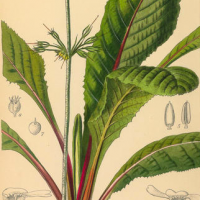The Wonderful World of Monocots
Monocotyledons, commonly referred to as monocots, are flowering plants whose seeds typically contain only one embryonic leaf, or cotyledon. A quarter of the world’s known plants are monocots. They are the most economically important group of plants to humans today in agriculture, horticulture, forestry and fiber industries. Here are a few samples of monocots in our plant collections.
1) Allium schubertii (Ornamental Tumbleweed Onion)
Dried seed heads look like starry tumbleweeds or shooting star fireworks
Located in the Soest Herbaceous Display Garden, bed 6 at the Center for Urban Horticulture
2) Austroderia richardii syn Cortedaria r.
Read moreRecipe: Vietnamese Salad

By Josh Furman
The first CSA box truly gave us an opportunity to eat fresh, and this recipe allows you to use up a number of items that will continue appearing in your box. This salad comes together in a flash, and is great for midweek. A bright dressing, fresh herbs, and different textures make this a fun salad to eat on the side or a substantive entree with the addition of a protein.
Glimpse into the past – Changes in the Landscape
by John A. Wott, Director Emeritus
Currently there are many physical changes occurring in the north end of the Washington Park Arboretum, due to the construction of new SR-520 bridge. Local residents often remark that these changes will “disfigure” the natural landscape which has always been there. The truth is, this area has been greatly changed and altered over the past one hundred years, ever since the level of Lake Washington was lowered.
Recipe: Saving Spring with Flavored Vinegar and Liqueurs
By Josh Furman
They say that April showers bring May Flowers, but it’s our crazy Spring that has covered plants in blossoms and caused vegetables and herbs to bolt sooner than expected. The flavors of the season are quickly passing us by, so take the opportunity to use the blooms in some flavorful infusions. You can really mix and match to your taste preferences, but here are a few ideas:
Chive Blossom Vinegar- This beautiful magenta vinegar is a great flavor enhancer in salad dressings.
Another Successful BioBlitz!
Citizen scientists and experts join forces to inventory species at the UW Botanic Gardens BioBlitz!
Read moreRecipe: Springtime Kimchi
By Josh Furman
This is a great blueprint for a Kimchi that can be made throughout the growing season. A more traditional Kimchi can be made with napa cabbage and daikon radish, but the recipe is incredibly flexible, and allows you to try whatever ingredients you find in your CSA box or at the farmers market. Napa cabbage can replace bok choy, green onions can replace garlic scapes, all radish/no radish, all carrot/no carrot, throw in some kohlrabi….the opportunities are endless!
Read moreFaculty Spotlight: Tom Hinckley

Tom Hinckley no doubt kept his much younger graduate students challenged to keep up as he climbed to over 7000′ on Snowshoe Mountain in the North Cascades. It was there he chose to conduct research on the effects of environmental stress on three species of native trees.
Hinckley needed that energy as he served both as Director for the UW Botanic Gardens’ Center for Urban Horticulture (1998-2004), and as researcher, teacher and mentor at the UW School of Environmental and Forest Sciences, where he is now emeritus professor.
Spring Pushes Forth at the Washington Park Arboretum
1) Ostrya carpinifolia Hop Hornbeam
This small-to-medium-sized tree (40-50’) is native to southern Europe and southwestern Asia.
The common name refers to the fruit which resembles the fruit of Humulus (Hops).
Ostrya is from Greek, meaning “bone-like” in reference to the trees dense hard wood.
Located north of East Foster Island Road, east of the Broadmoor entrance.
2) Picea mariana ‘Doumetii’ Doumet Black Spruce
This selection of Picea mariana is a popular slow-growing shrub with blue green needles and a dense conical growth habit.
Read moreMay Colors Appear Just in Time for Mother’s Day!
Happy Mother’s Day!
1) Philadelphus coronarius
Native to southeastern Europe and Asia Minor, this shrub is located within the Sorbus Collection. It is perhaps the best-known species of mock orange in gardens because of its sweet smell. The fragrance of its flowers is pleasing out-of-doors, but may become too strong if the plants are numerous or near sitting room windows.
Philadelphus is a member of the plant family, Hydrangeaceae.
